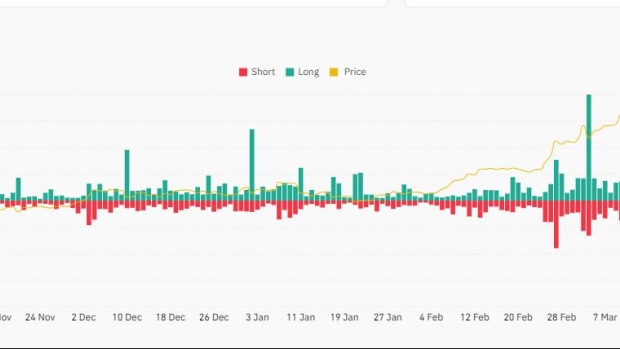Apr 12, 2024
Bitcoin Declines as the Liquidation of Bullish Bets Accelerate
, Bloomberg News

(Bloomberg) -- Bitcoin briefly dropped by the most in more than a month, helping to trigger a string of liquidations of speculative crypto positions that led to a rout in smaller digital assets such as Solana, Cardano and Polkadot.
Coinglass data show about $780 million worth of bullish crypto wagers were liquidated in the past 24 hours — the largest such drop in a month. The financial world was roiled on Friday by a flare-up in geopolitical risks that spurred a flight to the safest corners of the market such as bonds and the dollar.
Ether, the second-biggest cryptocurrency after Bitcoin, was down as much as 12% at one point, the biggest intraday decline since November 2022. It later pared the drop. The token has been under pressure since the Ethereum Foundation revealed last month that it was under scrutiny from the the US Securities and Exchange Commission.
“As cryptocurrencies across the board embrace correlation to risk assets, the slight decline in price quickly turned into an all-out cascade of liquidations,” said Chris Newhouse, DeFi analyst at Cumberland Labs.
Bitcoin fell as much as 7.5% to $65,214, before paring losses. Solana and Dogecoin slumped more, declining around 12% and 13%, respectively. Cardano and Polkadot each tumbled around 15%.
The sudden rout came on the back of rising Bitcoin prices in part driven by Bitcoin halving, a code update that has been perceived as a positive catalyst for the market as it will reduce the supply of the digital asset. Bitcoin is still up around 60% this year.
Ravi Doshi, head of markets at FalconX, said they’re now seeing buyers come in to take advantage of this opportunity ahead of the halving next week.
Even so, one of the options market’s closely watched indicators is starting to show that speculators are getting nervous ahead of the once-every-four-years Bitcoin code adjustment, which has been bullish for the cryptocurrency in the past. The halving is expected to take place around April 20.
The implied volatility for Bitcoin options jumped last weekend, reversing a downward trend seen in the prior week, Kaiko Research said in a report. An increase generally means market participants are less confident about the direction of prices, said Adam McCarthy, a research analyst at Kaiko. When implied volatility rises, traders are usually willing to pay more to protect existing positions or to speculate on potential prices moves — up or down.
©2024 Bloomberg L.P.





